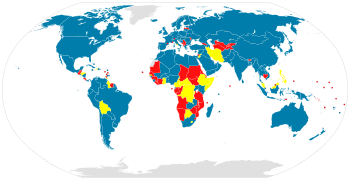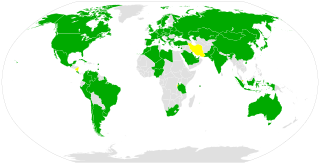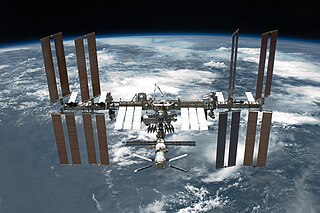| Treaty on Principles Governing the Activities of States in the Exploration and Use of Outer Space, including the Moon and Other Celestial Bodies | |
|---|---|
 Parties Signatories Non-parties | |
| Signed | 27 January 1967 |
| Location | London, Moscow and Washington, D.C. |
| Effective | 10 October 1967 |
| Condition | 5 ratifications, including the depositary Governments |
| Parties | 115 [1] [2] [3] [4] |
| Depositary | Governments of the United Kingdom of Great Britain and Northern Ireland, the Union of Soviet Socialist Republics and the United States of America |
| Languages | English, French, Russian, Spanish, Chinese and Arabic |
| Full text | |
The Outer Space Treaty, formally the Treaty on Principles Governing the Activities of States in the Exploration and Use of Outer Space, including the Moon and Other Celestial Bodies, is a multilateral treaty that forms the basis of international space law. Negotiated and drafted under the auspices of the United Nations, it was opened for signature in the United States, the United Kingdom, and the Soviet Union on 27 January 1967, entering into force on 10 October 1967. As of March 2024 [update] , 115 countries are parties to the treaty—including all major spacefaring nations—and another 22 are signatories. [1] [5] [6]
Contents
- Provisions
- Responsibility for activities in space
- Applicability in the 21st century
- 1976 Bogota Declaration
- Influence on space law
- List of parties
- Partially recognized state abiding by treaty
- States that have signed but not ratified
- List of non-parties
- See also
- References
- Further reading
- External links
The Outer Space Treaty was spurred by the development of intercontinental ballistic missiles (ICBMs) in the 1950s, which could reach targets through outer space. [7] The Soviet Union's launch of Sputnik, the first artificial satellite, in October 1957, followed by a subsequent arms race with the United States, hastened proposals to prohibit the use of outer space for military purposes. On 17 October 1963, the U.N. General Assembly unanimously adopted a resolution prohibiting the introduction of weapons of mass destruction in outer space. Various proposals for an arms control treaty governing outer space were debated during a General Assembly session in December 1966, culminating in the drafting and adoption of the Outer Space Treaty the following January. [7]
Key provisions of the Outer Space Treaty include prohibiting nuclear weapons in space; limiting the use of the Moon and all other celestial bodies to peaceful purposes; establishing that space shall be freely explored and used by all nations; and precluding any country from claiming sovereignty over outer space or any celestial body. Although it forbids establishing military bases, testing weapons and conducting military maneuvers on celestial bodies, the treaty does not expressly ban all military activities in space, nor the establishment of military space forces or the placement of conventional weapons in space. [8] [9] From 1968 to 1984, the OST gave birth to four additional agreements: rules for activities on the Moon; liability for damages caused by spacecraft; the safe return of fallen astronauts; and the registration of space vehicles. [10]
OST provided many practical uses and was the most important link in the chain of international legal arrangements for space from the late 1950s to the mid-1980s. OST was at the heart of a 'network' of inter-state treaties and strategic power negotiations to achieve the best available conditions for nuclear weapons world security. The OST also declares that space is an area for free use and exploration by all and "shall be the province of all mankind". Drawing heavily from the Antarctic Treaty of 1961, the Outer Space Treaty likewise focuses on regulating certain activities and preventing unrestricted competition that could lead to conflict. [7] Consequently, it is largely silent or ambiguous on newly developed space activities such as lunar and asteroid mining. [11] [12] [13] Nevertheless, the Outer Space Treaty is the first and most foundational legal instrument of space law, [14] and its broader principles of promoting the civil and peaceful use of space continue to underpin multilateral initiatives in space, such as the International Space Station and the Artemis Program. [15] [16]













